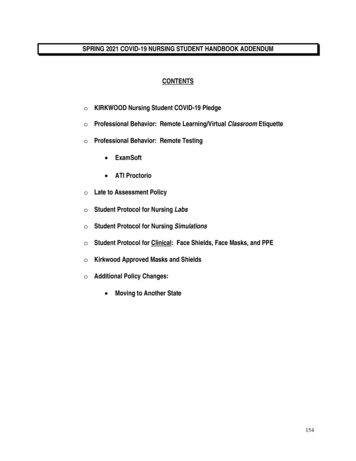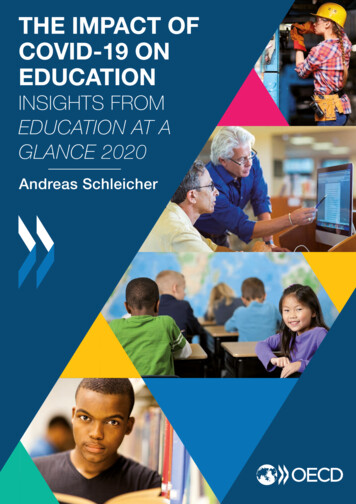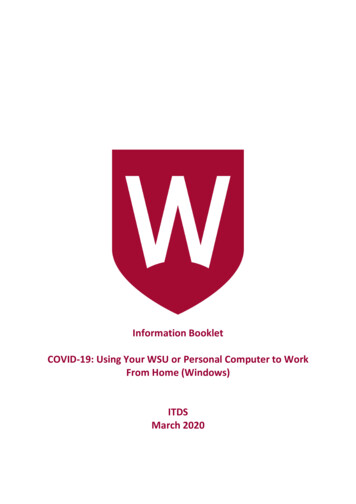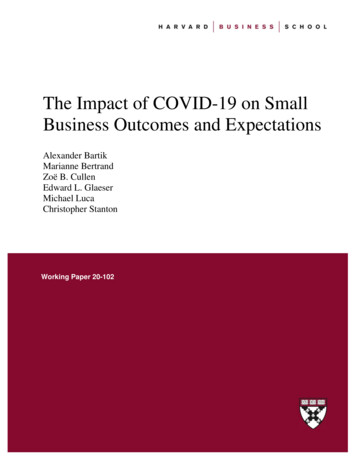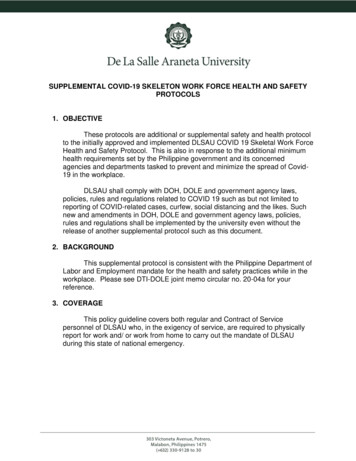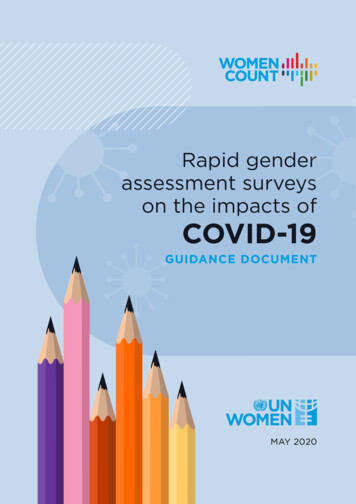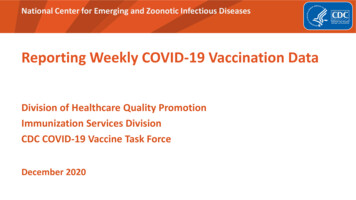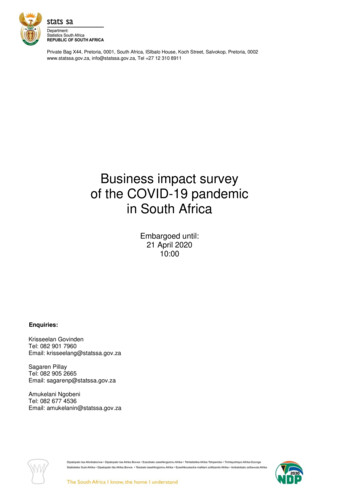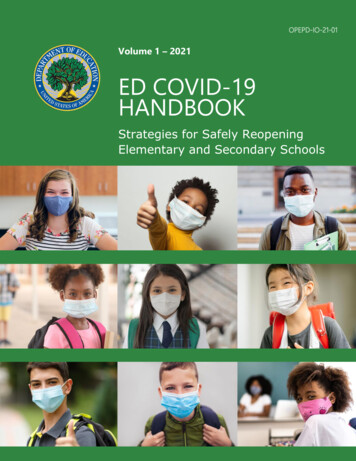
Transcription
OPEPD-IO-21-01Volume 1 – 2021ED COVID-19HANDBOOKStrategies for Safely ReopeningElementary and Secondary Schools
U.S. Department of EducationDr. Miguel A. CardonaSecretary of EducationOffice of Planning, Evaluation and Policy DevelopmentDonna M. Harris-AikensActing Assistant SecretaryInitially released in February 2021; updated April 2021; updated August 2021The updates included in this Volume of the ED COVID-19 Handbook are based on the mostrecent Centers for Disease Control and Prevention (CDC) Guidance issued as of August 17, 2021.For the most recent CDC guidance issued after the release of this Volume – and how to considerthe strategies included in this resource within the context of the most up to date guidance –please visit: y/schools-childcare/k-12guidance.html.Summary of Changes in August 2021 Update: Added language on the importance of offering in-person learning, regardless of whetherall of the prevention strategies identified in this document can be implemented at theschool.Revised to emphasize the COVID-19 prevention strategies most important for in-personlearning for K-12 schools.Updated to reflect that vaccination is the leading prevention strategy to end the COVID19 pandemic and reflect that promoting vaccination can help schools safely return to inperson learning as well as extracurricular activities and sports.Updated to emphasize the need for localities to monitor community transmission,vaccination coverage, screening testing, and occurrence of outbreaks to guide decisionson the level of layered prevention strategies.Updated to align with guidance for fully vaccinated people and most recent maskguidance at the time of publication, which indicates that all people should wear masksin K-12 schools, regardless of vaccination status.This report is in the public domain. Authorization to reproduce it in whole or in part is granted.While permission to reprint this publication is not necessary, the citation should be U.S.Department of Education, Office of Planning, Evaluation and Policy Development, ED COVID-19Handbook, Volume 1: Strategies for Safely Reopening Elementary and Secondary Schools,Washington, DC, 2021. This report is available on the Department’s website ing.pdf.Availability of Alternate Formats
On request, this publication is available in alternate formats, such as Braille or large print. Formore information, please contact the Department’s Alternate Format Center at 202-260-0818or via e-mail at alternateformatcenter@ed.gov.Notice to Limited English Proficient PersonsIf you have difficulty understanding English, you may request language assistance services forDepartment information that is available to the public. These language assistance services areavailable free of charge. If you need more information about interpretation or translationservices, please call 1-800-USA-LEARN (1-800- 872-5327) (TTY: 1-800-877-8339), email us atEd.Language.Assistance@ed.gov, or write to U.S. Department of Education, InformationResource Center, 400 Maryland Ave., SW, Washington, DC 20202.
ContentsIntroduction . 1Summary of CDC Operational Strategies and Steps for Safe School Reopening . 3Safe Practices for In-Person Learning . 8Promoting Vaccination. 8Masking Practices . 9Physical Distancing Practices . 11Cohorting/Podding and Staffing Considerations for Physical Distancing . 15Transportation Considerations . 17Staying Home When Sick and Getting Tested. 18Handwashing and Respiratory Etiquette . 19Safety Considerations Related to Music, Arts, and Athletics Programs . 19Supporting Ongoing Engagement with Educators, Families, and the School Community . 22
IntroductionPresident Biden committed to seeking the necessary resources to support the safe reopeningand continued operation of schools. As stated in Executive Order 14000, Supporting theReopening and Continuing Operation of Schools and Early Childhood Education Providers, everystudent in America deserves a high-quality education in a safe environment. The Biden-HarrisAdministration believes strongly that returning to in-person learning as soon as possible isessential for all students and families, and has taken decisive action to support the safereopening of schools for in-person instruction and to address the needs of students. Inparticular, updated guidance reflects the need for all students (age 2 and older), educators,staff, and visitors to K-12 schools to wear masks consistently and correctly, regardless ofvaccination status.The Administration recognizes the unique challenges students in underserved communitiesface, including students from low-income backgrounds, students of color, LGBTQI students,English learners, students with disabilities, American Indian and Alaska Native students,students who are migratory, students in foster care, students in correctional facilities, andstudents experiencing homelessness. Such students are less likely to have access to thebroadband, resources, and other supports required to participate in high-quality remoteeducation. They also are more likely to rely on key school-supported resources, such as foodprograms, special education and related services, counseling, and after-school programs tomeet basic developmental needs. For parents and guardians/caregivers (referenced collectivelyhereafter in this volume as “parents”) who have less-flexible jobs, staying at home to providecare for their children and aid with remote learning might be impracticable or impossible.While the pandemic has impacted all communities and students, it has had a particularlydevastating impact on communities and people of color, as described in the Department’sOffice for Civil Rights report Education in a Pandemic: The Disparate Impacts of COVID-19 onAmerica’s Students.To fully reopen schools safely for in-person learning, schools need strong state and local publichealth measures that everyone follows. Achieving high levels of COVID-19 vaccination amongeligible students as well as teachers, staff, and household members is one of the most criticalstrategies to help schools safely resume full operations. Vaccination is the leading public healthprevention strategy to end the COVID-19 pandemic. People who are fully vaccinated againstCOVID-19 are at low risk of symptomatic or severe infection. In general, people are consideredto be fully vaccinated two weeks after their second dose in a two-dose series (such as the Pfizeror Moderna vaccines) or two weeks after a single-dose vaccine (such as Johnson and Johnson’sJanssen vaccine). People 12 years and older are eligible for COVID-19 vaccination. The Centersfor Disease Control and Prevention (CDC) also recommends that individuals who aremoderately to severely immunocompromised and who have received two mRNA COVID-19vaccine doses receive a third dose of mRNA COVID-19 vaccine at least 28 days after theirsecond dose.1
Schools can promote vaccinations among teachers, staff, families, and students by providinginformation about COVID-19 vaccination, encouraging vaccine trust and confidence, andestablishing supportive policies and practices that make getting vaccinated as easy andconvenient as possible. The President has called on school districts nationwide to host at leastone pop-up vaccination clinic over the coming weeks. To address this call to action, schoolsshould, for example, consider partnering with state or local health authorities to serve asCOVID-19 vaccination sites, and work with local healthcare professionals and organizations,including school-based health centers. Offering vaccines on-site before, during, and after theschool day and during school events can potentially decrease barriers to getting vaccinatedagainst COVID-19. Additional information can be found in the Back to School Toolkit and theGuide to On-Site Vaccination Clinics for School. In addition, the Administration is directingpharmacies in the Federal Retail Pharmacy Program to prioritize vaccinations for youth and towork with school districts across the country to host vaccination clinics at schools and colleges.The CDC recommends that all people wear masks inside schools regardless of vaccinationstatus. The CDC also recommends schools maintain physical distance to the maximum extentpossible. Schools should communicate their strategies and any changes in plans to teachers,staff, and families, and directly to students, using accessible materials and communicationchannels, in a language (including non-English languages and American Sign Language (ASL))and at a literacy level that is accessible for teachers, staff, students, and families. For example,schools could use social media platforms and other tools to quickly disseminate information,while taking care to ensure access for all. Consistent implementation of effective strategies forpreventing the transmission of COVID-19 during all school-related activities is critical forreopening schools for in-person learning—and keeping them open for in-person learning.Schools and districts can utilize American Rescue Plan (ARP) funds to support this critical work.It is essential that all schools and students receive the resources, including personal protectiveequipment (PPE), such as masks; technical assistance; and other supports necessary to plan andimplement comprehensive prevention strategies and safely reopen schools for in-personlearning. It is also essential that district and school leaders and educators consistently engageparents and community partners throughout the process—paying close attention tocommunities who have borne a disproportionate burden of COVID-19. School administratorscan offer modified job responsibilities for staff and teachers at higher risk for severe illness whohave not been vaccinated while protecting individual privacy. Additional information isavailable in the section of CDC Guidance for COVID-19 Prevention in K-12 Schools related toschool workers.This is the first volume in the U.S. Department of Education (ED) COVID-19 Handbook, a seriesintended to support the education community as schools reopen for in-person learning. Thisseries provides tools to aid educators in implementing CDC’s Guidance for COVID-19 Preventionin K-12 Schools. ED has also released Volume 2: Roadmap to Reopening Safely and Meeting AllStudents’ Needs and Volume 3: Strategies for Safe Operation and Addressing the Impact ofCOVID-19 on Higher Education. For schools that serve younger children, including Pre-K andHead Start programs, please consult CDC’S COVID-19 Guidance for Operating Early Care and2
Education/Child Care Programs. The U.S. Department of Health and Human Services also issuedresources to support early childhood education and child care providers.Other than statutory and regulatory requirements referenced in the document, the contents ofthis guidance do not have the force and effect of law and do not bind the public. This documentis intended only to provide clarity to the public regarding existing requirements under the lawor agency policies.Summary of CDC Operational Strategies and Steps for Safe School ReopeningCDC recently updated its Guidance for COVID-19 Prevention in K-12 Schools and a relatedscientific brief regarding schools. The CDC Guidance for COVID-19 Prevention in K-12 Schoolsmakes recommendations based on the best-available evidence, which indicates that K-12schools can open safely for in-person instruction and remain open by implementing layeredprevention strategies including:1.2.3.4.5.6.7.8.Promoting vaccination;Universal, consistent, and correct mask use;Physical distancing;Screening testing to promptly identify cases, clusters, and outbreaks;Ventilation;Handwashing and respiratory etiquette;Staying home when sick and getting tested;Contact tracing in combination with isolation for infected individuals and quarantine forclose contacts, as defined by the CDC; and9. Cleaning and disinfection.While each of these strategies is important, emphasis should be placed on promotingvaccination, universal and correct indoor masking, and physical distancing, though schoolsshould not exclude students from in-person learning to keep a minimum distance requirement.Students benefit from in-person learning, and safely returning to in-person instruction is apriority.Schools can partner with local health departments to provide necessary testing to students andfamilies, as appropriate, and in compliance with applicable privacy laws, including the FamilyEducational Rights and Privacy Act (FERPA), Part B of the Individuals with Disabilities EducationAct (IDEA), and the Protection of Pupil Rights Amendment (PPRA). Expanding screening testingcan help reassure parents that it is safe to send their child to school, reassure educators it issafe to return in person, and identify cases. When a positive test result is reported, contacttracing, isolation (for people who test positive), and quarantine (for people who are closecontacts to someone who tested positive) can limit secondary transmission in schools.District and school leaders should consider the following steps when developing reopeningplans or plans to keep schools open and safe for students, educators, staff, and families:3
Promote vaccination. Vaccination is the leading public health prevention strategy toend the COVID-19 pandemic. Schools can support teachers, staff, students, and theirfamilies in getting vaccinated by serving as a vaccination site, providing informationabout vaccination locations near school, and responding to questions and concernsusing information sessions and other strategies described in CDC’s vaccination toolkitsfor schools and health departments. They can also offer supportive sick leave options(e.g., paid sick leave) for employees to get vaccinated or who have side effects aftervaccination or excused absences for students to get vaccinated or who have side effectsafter vaccination. Additional information can be found in the Guide to On-SiteVaccination Clinics for School. Continuously review and analyze community data and plan accordingly. District andschool leaders should review levels of vaccination coverage, community transmission,strain on health system capacity, and local guidelines to plan for in-person learning.Tools and resources on developing an Emergency Operations Plan are available fromED’s Readiness and Emergency Management Technical Assistance Center. Require universal indoor mask use, which means requiring all teachers, staff, students,and visitors to K-12 schools to wear a mask correctly and consistently while indoors,regardless of their vaccination status and transmission level. Indoors, consistent andcorrect wearing of masks (covering the mouth and nose with a mask that fits to theface) that provide the necessary protection should be required, as permitted byapplicable state and local laws and regulations, except for people who cannot safelywear a mask, as further described below. In addition, people who are not fullyvaccinated should wear a mask outdoors if they are in crowded settings or duringactivities that involve close contact with others. Fully vaccinated people might choose towear a mask in crowded outdoor settings if they or someone in their household isimmunocompromised.It is important to ensure all students and staff participating in in-person learning haveaccess to and know how to correctly wear masks. Emerging evidence suggests thatvaccinated people can transmit the virus, which is why CDC updated its guidance toindicate that all people should wear masks in K-12 schools regardless of theirvaccination status. If it is helpful to ensure that a mask fits well, wearing a cloth maskover a disposable mask is one option. Schools should require consistent and correctwearing of masks indoors for individuals regardless of vaccination status and identifyand determine how best to support staff and students who cannot correctly wear masksor need accommodations (see “Masking Practices” section below). Schools should offermasks to those students who need them, such as students who either forgot to bring intheir mask or whose families are unable to afford them.The narrow subset of students with disabilities who cannot wear a mask because oftheir disability, or cannot safely wear a mask, can still attend school safely if otherprevention strategies can be followed, including, for example, correct masking for4
others who work or learn with them and physical distancing. Adaptations andalternatives, such as additional facial protections, can be considered for educators andother students and who work with or learn with such students, in addition to physicaldistancing. Public schools must provide a free appropriate public education (FAPE) asrequired by federal disability law in both in-person and remote learning environments.Additional considerations and examples for implementing universal masking aredescribed below in greater detail in the “Safe Practices for In-Person Learning” sectionof this Handbook. Plan the use of space to allow physical distancing. Because of the importance of inperson learning, schools should implement physical distancing to the extent possible butshould not exclude students from in-person learning to keep a minimum distancerequirement. Schools should implement at least 3 feet of physical distancing betweenstudents in classrooms to the extent possible within their structures, combined withindoor mask wearing to reduce risk.In general, CDC recommends people who are not fully vaccinated maintain physicaldistance of at least 6 feet from other people who are not in their household. However,several studies from the 2020-2021 school year show low COVID-19 transmission levelsamong students in schools that had less than 6 feet of physical distance when the schoolimplemented and layered other prevention strategies, such as the use of masks.School leaders can work with educators, facility staff, and community leaders to identifysufficient safe space that allows for physical distancing, making adjustments as neededto classroom layouts. CDC provides a resource showing possible ways to set up aclassroom to facilitate physical distancing. School leaders should conduct a school walkthrough to identify any classrooms or spaces where additional changes might be neededwhen preparing to reopen for in-person learning. School leaders can also identify othersafe spaces in the community that might be available and suitable for instruction tomaintain physical distancing, such as libraries and community recreational centers.Educators should be provided additional collaboration and planning time before theschool reopening to redesign their classroom space and develop and coordinate newroutines among staff to support physical distancing to the extent possible. In addition tocollaborating with teachers and paraprofessionals, school leaders can identifyopportunities to establish or expand partnerships, for example, with community-basedorganizations to provide adult supervision for sections of classes that need to meet indifferent rooms while differentiating such roles from educators’ positions (see “PhysicalDistancing Practices” section below). Establish a screening testing program in accordance with applicable law including, butnot limited to, the Protection of Pupil Rights Amendment (PPRA) (20 U.S.C. 1232h).Screening testing can help promptly identify and isolate cases to reduce the risk to inperson education. Screening testing is especially important in areas with substantial or5
high community transmission levels, in areas with low vaccination coverage, and inschools where one or more of the other prevention strategies is not implemented. Ifavailable, saliva tests and nasal tests that use a short swab may be more easilyimplemented and accepted in schools. CDC guidance states that vaccinated people donot need to participate in a screening testing program.Testing post-exposure is considered diagnostic testing and is different from screeningtesting, which is intended to identify unvaccinated people with COVID-19 who areasymptomatic and do not have known, suspected, or reported exposure to SARS-CoV-2.Screening helps to identify unknown cases so that measures can be taken to preventfurther transmission.CDC identifies four categories of community transmission of COVID-19 as defined at theCDC COVID-19 Data Tracker—low (blue), moderate (yellow), substantial (orange), orhigh (red)—based on two metrics: (1) total new cases per 100,000 persons in the past 7days and (2) percentage of positive tests in the past 7 days.1 If the two indicatorssuggest different transmission levels, the higher level is selected. School and districtleaders can refer to the CDC COVID-19 Data Tracker for county-level data.CDC’s guidance then advises on how to use the thresholds determined by these metricsto design a screening testing program (see Table 1 of the Guidance for COVID-19Prevention in K-12 Schools): At low (blue) levels (i.e., 0-9 new cases per 100,000 persons in the past 7 daysand 5% of positive tests in the past 7 days): Students do not need to participatein screening testing, and screening testing is not needed for low- andintermediate-risk sports or activities.2 CDC recommends schools offer screeningtesting at least once per week for (a) teachers and staff who are not fullyvaccinated and (b) participants in high-risk sports and activities who are not fullyvaccinated. See the section below on “Safety Considerations Related to Music,Arts, and Athletics Programs” for more information. At moderate (yellow) levels (i.e., 10-49 new cases per 100,000 persons in thepast 7 days and 5-7.9% of positive tests in the past 7 days): CDC recommendsschools offer screening testing at least once per week for (a) students who arenot fully vaccinated; (b) teachers and staff who are not fully vaccinated; and (c)participants in sports and activities who are not fully vaccinated, regardless ofthe level of risk of the sport or activity.1The total number of new cases per 100,000 people can be calculated by adding the number of new cases in the county (orother community type) in the last 7 days divided by the population in the county (or other community type) and multiplying by100,000.2 Examples of low-risk sports are diving and golf; intermediate-risk sport examples are baseball and cross country; high-risksport examples are football and wrestling. High-risk extracurricular activities are those in which increased exhalation occurs,such as activities that involve singing, shouting, band, or exercise, especially when conducted indoors.6
At substantial (orange) levels (i.e., 50-99 new cases per 100,000 persons in thepast 7 days and 8-9.9% of positive tests in the past 7 days): CDC recommendsschools offer screening testing at least once per week for (a) students who arenot fully vaccinated; (b) teachers and staff who are not fully vaccinated; and (c)participants in low- and intermediate-risk sports and activities who are not fullyvaccinated. CDC recommends screening testing twice per week for participantsin high-risk sports or activities. At high (red) levels (i.e., 100 new cases per 100,000 persons in the past 7 daysand 10% of positive tests in the past 7 days): CDC recommends schools offerscreening testing at least once per week for (a) students who are not fullyvaccinated; (b) teachers and staff who are not fully vaccinated; and (c)participants in low- and intermediate-risk sports and activities who are not fullyvaccinated. CDC recommends that high-risk sports or activities be cancelled orheld virtually to protect in-person learning, unless all participants are fullyvaccinated. Collaborate with local public health officials in compliance with applicable privacylaws, including the Family Educational Rights and Privacy Act (FERPA)(20 U.S.C.1232g), the Individuals with Disabilities Education Act (IDEA) (20 U.S.C. 1400 et seq.),and PPRA, on such matters as supporting screening testing3 and diagnostic testing (i.e.,for those with symptoms or who have had close contact with someone who testspositive for COVID-19) for students, educators, and staff. For students, teachers, andstaff who receive a positive test or diagnosis of COVID-19, collaborations with publichealth officials are necessary to conduct case investigation and contact tracing andidentify close contacts for referrals to diagnostic testing and quarantine. Collaborationwith local public health officials should also include approaches to promotingvaccination in the school and community. Improve ventilation to the greatest extent possible, including, minimally, by openingwindows and doors and using fans where safe and feasible. Schools can use HVACsettings and exhaust fans to maximize safety and provide portable carbon dioxidemonitors to verify how well air is circulating in classrooms and other spaces. Tools fromCDC or the Environmental Protection Agency (EPA) can help. For example, districts andschools can schedule incremental checkpoints to ensure plans for updating ventilationare going according to schedule and increase the frequency of changing ventilationfilters. In addition, the Council of the Great City Schools has developedrecommendations on ventilation and improving air quality and created a checklist thatmight be useful to schools. The New York City Department of Education also has aschool building ventilation survey that is publicly available and can be used or modified3Screening testing identifies infected people, including those with or without symptoms (or before development of symptoms)who may be contagious, so that measures can be taken to prevent further transmission.7
by other school districts. ED released additional information on improving ventilation inschools, colleges, and universities to prevent COVID-19, including how ARP educationfunds can support this critical work. Determine the format for sports, other extracurricular activities, and school eventsbased on CDC guidance and additional information below on supporting student accessto a well-rounded education, ensuring all students have access to these opportunitieson a nondiscriminatory basis, and recognizing that in-person instruction should beprioritized. Some activities—specifically, those that require close contact amongparticipants—pose a higher risk than others that involve the least physical contact orrespiratory exertion. Please see the section below on “Safety Considerations Related toMusic, Arts, and Athletics Programs.” CDC recommends that schools use screeningtesting, as described above, to promote safety in such activities and to keep schools safefor in-person learning.Safe Practices for In-Person LearningThe recommendations in this section complement existing CDC guidance and provide additionaldetails about implementing the principles outlined above. District and school leaders andeducators should consider the following practices as they provide continuity of instruction,including in-person learning to the greatest extent safely feasible.Promoting VaccinationVaccination is the leading strategy for ending the COVID-19 pandemic. Schools shouldencourage teachers, staff, students, and families, including extended family members who havefrequent contact with students, to get vaccinated as soon as they can. The Back to SchoolToolkit has resources for school districts, educators, staff, parents, and school supporters whowant to help increase confidence in and uptake of COVID-19 vaccines in their schoolcommunities. Schools should partner with state or local health authorities to serve as COVID-19vaccination sites, and work with local healthcare professionals and organizations, includingschool-based health centers. Offering vaccines on-site before, during, and after the school dayand during school events, such as performances or games, can potentially decrease barriers togetting vaccinated against COVID-19. Schools may also use ARP funds under the U.S.Department of the Treasury’s Coronavirus State and Local Fiscal Recovery Funds and ED’sEducation Stabilization Fund to provide incentives to students to get the COVID-19 vaccination.For additional information, please see frequently asked questions on this topic. In addition, theAdministration is directing pharmacies in the Federal Retail Pharmacy Program to prioritizevaccinations for youth and to work with school districts across the country to host vaccinationclinics at schools and colleges.School and health professionals can be trusted sources to explain the safety, efficacy, andbenefits of COVID-19 vaccines. COVID-19 vaccines may be administered to most people withunderlying medical conditions. CDC has additional information on COVID-19 vaccination for8
people with underlying medical conditions. Federal and state disability laws may require anindividualized approach for working with children and you
To fully reopen schools safely for in-person learning, schools need strong state and local public health measures that everyone follows. Achieving high levels of COVID-19 vaccination among eligible students as well as teachers, staff, and household members is one of the most critical strategies to hel
